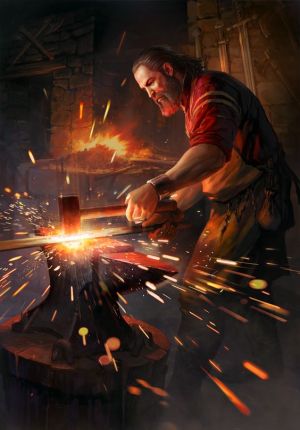Magic items
From Vanathul Wiki
Availability
At character creation
As a rule, a character that is being created have the choice of any magic item they can afford with their starting wealth.
Purchasing magic items
As per the standard rules the availability of magic items is dependent on where the character is doing their shopping. If you are unsure of what category a city or village fall under, ask your GM.
Creation
Take care when working magic into your creations. Regularly doing so will attract the attention of gremlins. If not handled swiftly and properly, these critters will warp your tools, foul your reagents or even hurt you and your colleagues.Geoff Sciller, on proper workshop mantinence.
Magic item creation
As per Existing Magic Items
An items cost is usually stated in its stat block. It's otherwise similar to the standard rules of item creation. 1 bell/1000 gp purchace price of the item per 8-hour workbell as the craft cost is usually half that of the ordinary price. This is the regular maximum hours someone can effectively work on an item per bell.
For items worth 1000 gp or less, the base crafting speed is 125 gp value/hour (or 62,5 gp crafting cost/hour)
Item creation feats or abilities that states their own crafting time takes precedence over this general rule.
I am willing to try the Dynamic Magic Item Creation rules for any magic items crafted by players.
Upgrading
The cost of uprading an item to a version that is more powerful, such as upgrading a Cloak of resistance from a +1 bonus to a +2, the cost is usually as simple as providing the difference between the two versions to a crafter able to create the upgraded one. This cost includes the profit for the crafter, and reflects the time and wage the upgrade will take for the job.
Adding properties to an item such as a weapon or armor fall under this category, and follow the same rules for cost and crafting time as other crafting.
If a player character is employed to perform the upgrade, the calculation is done with the creation cost of the item instead of the purchase cost, and it is up to the crafter to negotiate the cost of the service, if any.
Combining
The cost of combining two magic items sharing a slot is calculated based on the individual prices of the two items that are being combined.
Simply put, the most expensive item determines the base cost, and the other items being added have their price multiplied by 1.5. These prices are then all added together, and gives the total cost of the resulting item. This ensures the lowest resulting cost.
An example is the Wizard Academy Expeditionary Coat. Which is a combined Cloak of resistance and a Cloak of the Hedge Wizard. In the case of a +1 resistance bonus, the constituent items cost 2500 gp and 1000 gp. The total combined item cost would be 4000, since base cost is 2500 gp and the multiplied cost of the item that is being added is 1500 gp (1000 gp × 1.5).
If the same example would be calculated with a +2 resistance bonus the base item would change in the cost calculation, since 4000 gp is greater than 2500 gp. The total cost of this item would then be 7750 gp, since the new base cost would be 4000 gp, and the other items effect would cost 3750 gp to add (2500 gp × 1.5)
When upgrading items that have been combined, or when combining three or more items, the amount of gp needed is calculated as if the item was created anew. This is to make sure the correct base item is used, and that the result is therefore the correct price.
Creating custom items
There are situations where players desires to create a custom magic item. In these cases it is important to communicate with your DM.
The quick and dirty guidelines are:
- physical ability increases belt slot items
- mental ability increases as headgear
- movement modification as legwear
- etc.
Refluffing
Necessary refluffing
Due to the customized nature of the setting, several magic items will be out of place or localized to certain continents. This imposes a limiting factor on availability from a lore standpoint that does not need to be there from a mechanics perspective.
In these cases it is preferable that the item be changed cosmetically to reflect its origin, while maintaining all its properties.
An example is the ever useful Ioun torch. On the continent of Orn there are no Ioun stones, and as such there can be no Ioun torches. As an alternative anyone wishing to use one will be asked to "refluff" it to something more fitting, while still maintaining the advantages and disadvantages of the original item. An alternative is a jewelry of some sort that does not require a slot, but that can be "netted" or stolen with the same effort.
The following are examples of items subject to this kind of refluffing:
- Ioun stones
- Jewelry like ear rings, or an amulet (which would not interfere with the neck magic item slot) or other similarly snatchable location.
- Hand of the Mage
- some other amulet not necessarily made from the hand of an elf.
- Feather tokens
- preferably something not resembling pokéballs
Incidental refluffing
Another category is those items that does not necessarily have to come in the shape stated in its entry. They are still mechanically identical, but can vary greatly from the original in "fluff".
For example a selective spell metamagic rod can be represented as a censer the user wields in stead of a rod. The caveat is that the item requires the same time to draw and stow, has the same item creation prerequisites, and is essentially still treated as a rod.
Another example is a wand that does not need to take the shape of a small stick. It can just as easily be a skull shooting scorching rays out of its eye sockets. It would still require the use of a hand to operate. This change would make hiding a "wand" like this a bit more challenging, as would embedding it in a customized pommel, but let us cross that bridge if we come to it. Other suggestions could be a carried amulet or an ancient rusted gauntlet, both can be functional "wands".
Ideally refluffing in this way should not change peripheral properties, but in some cases it is unavoidable.
Magic auras
Unspecified magic aura on items follow the following guidelines:
| Item Nature | School |
|---|---|
| Armor and protection items | Abjuration |
| Weapons or offensive items | Evocation |
| Bonus to ability score, skill check, etc | Transmutation |
As stated in the arcane sight spell aura strength is as follows:
| Aura Power | ||||
|---|---|---|---|---|
| Spell or Object | Faint | Moderate | Strong | Overwhelming |
| Functioning spell (spell level) | 3rd or lower | 4th-6th | 7th-9th | 10th+ (deity-level) |
| Magic item (caster level) | 5th or lower | 6th-11th | 12th-20th | 21st+ (artifact) |
If the item has only an enchantment bonus (like a +1 longsword), then the CL of the item is 3*enchantment bonus. So a +1 longsword would have a CL of 3, a +2 longsword would be CL 6, and so on.
| Original Strength | Duration of Lingering Aura |
|---|---|
| Faint | 1d6 rounds |
| Moderate | 1d6 minutes |
| Strong | 1d6x10 minutes |
| Overwhelming | 1d6 days |

